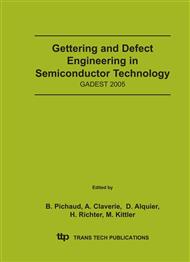[1]
Semiconductor Industry Association, International Technology Roadmap for semiconductors, 1994 Edition, (http: / public. itrs. net/files/1994 ITRS/Home. htm).
Google Scholar
[2]
P. K. Chu, C. Chan, Surface and coatings technology 136, (2001), pp.151-156.
Google Scholar
[3]
T. Homma, R. Yamaguchi, Y. Murao, J. Electrochem Soc 140, (1993), pp.3599-3603.
Google Scholar
[4]
S. Lin, C. Jin, M. Tsai, M. Daniels, A. Gonzalez, 4th Internationnal Interconnects Technology Conference, San Francisco, USA, IEEE, 4-6 June, pp.146-148.
Google Scholar
[5]
A. Grill, Diamond and Related Materials 10, (2001), pp.234-239.
Google Scholar
[6]
A. Jain, S. Rogojevic, S. Ponoth, N. Agarwal, I. Matthew, W. N. Gill, P. Persans, M. Tomozawa, J.L. Plawsky, E. Simonyi, Thin solid Film 398-399, (2001), pp.513-522.
DOI: 10.1016/s0040-6090(01)01311-6
Google Scholar
[7]
R.A. Van Santen, G.J. Kramer, Chem. Rev. 95, (1995), pp.637-630.
Google Scholar
[8]
J. Liu, D. Gan, C. Hu, M. Kiene, P.S. Ho, W. Volksen, R.D. Miller, Appl. Phys. Lett. 81, (2002), pp.4180-4182.
DOI: 10.1063/1.1525054
Google Scholar
[9]
A. Volinsky, J. Vella , W. Gerberich, Thin Solid Films 429, (2003), pp.201-210.
Google Scholar
[10]
C.L. Chang, T.J. Huang, Materials Science and Engineering B98, (2003), pp.45-53.
Google Scholar
[11]
C.C. Griffioen, J.H. Evans, P.C. de Jong, A. Van Veen, Nucl. Instr. and Meth. B27, (1987), p.147.
Google Scholar
[12]
E. Ntsoenzok, H. Assaf, M.O. Ruault, MRS Spring Meeting, San Francisco, 2005 Fig. 6 : Dielectric constant evolution as a function of porosity for different dielectrics. 6.
Google Scholar
[13]
G.W. Arnold, G. Battaglin, G. Mattei, P. Mazzoldi, S. Zandolin, Nucl. Instr. and Meth. B 166-167, (2000), pp.440-444.
Google Scholar
[14]
C.H. Zhang , K.Q. Chen, Y.S. Wang, J.G. Sun, D.Y. Shen, Journal of Nuclear Materials 245, (1997), p.210.
Google Scholar
[15]
S. Godey, T. Sauvage, E. Ntsoenzok, H. Erramli, M.F. Beaufort, J.F. Barbot, B. Leroy, J. Appl. Phys. 87, (1999), p.2158.
DOI: 10.1063/1.372155
Google Scholar
[16]
J.H. Golden, C.J. Hawker, P.S. Ho., Semiconductor International 24, no. 5, ( 2001), pp.79-88.
Google Scholar


